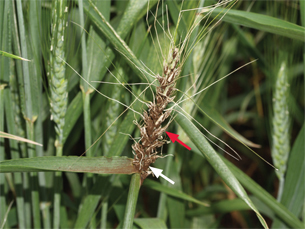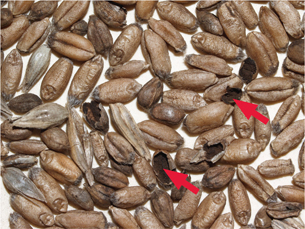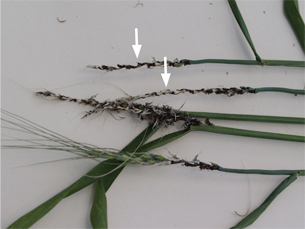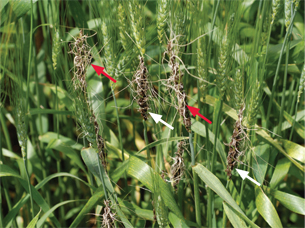G1978
Loose Smut and Common Bunt of Wheat
Loose smut and common bunt are fungal diseases common to wheat in Nebraska. Planting resistant cultivars and fungicide-treated seed will help with control and management.
Stephen N. Wegulo, Extension Plant Pathologist
- Cause and Occurrence
- Effect on Grain Quality and Yield
- Disease Symptoms
- Disease Cycle
- Favorable Environmental Conditions
- Management
- Acknowledgment
Cause and Occurrence
The smut diseases of wheat that occur in Nebraska are loose smut (Figure 1) and common bunt (stinking smut, Figure 2). Loose smut is caused by the fungus Ustilago tritici and common bunt is caused by the fungi Tilletia tritici and T. laevis. Both diseases can occur anywhere in the state where wheat is grown and are noticeable from heading to harvest. Rye, triticale, and some grasses also can be affected by both diseases.
 |
 |
|
| Figure 1. A loose smutted head with an olive-black spore mass (white arrow) and remnants of glumes and awns (red arrow). | Figure 2. Wheat kernels filled with black spores (arrows) of the common bunt fungus. |
Effect on Grain Quality and Yield
Loose smut does not affect grain quality. Infected grain is not visibly altered and its germination is not affected. Yield loss from loose smut is usually minimal (about 1 percent or less). However, the disease can cause losses as high as 25 percent or more in severe cases. In general, percent yield loss from loose smut is approximately equal to the percentage of affected wheat heads.
Common bunt reduces both grain quality and yield. Grain contaminated by bunt spores has a darkened appearance and a fishy, pungent smell. The smell is due to an organic compound, trimethylamine, which in appropriate concentrations can cause explosions in combines during harvest or in elevators during storage. Contaminated grain usually is discounted at the elevator and can be rejected altogether. It cannot be used as feed because the strong order causes livestock to reject it. However, it may be used in ethanol production.
Disease Symptoms
Symptoms of loose smut and common bunt are not apparent until head emergence. Before heading, dark green, erect leaves may be visible on plants infected by loose smut. Heads of infected plants emerge earlier, are darker in color, and are slightly taller than heads of healthy plants. Spikelets (units of inflorescence) of infected heads may be completely replaced by masses of olive-black spores, which may be removed and blown away by wind, leaving an empty rachis (Figure 3). When spikelet tissues are not completely destroyed, remnants of glumes or awns may remain attached to the rachis (Figures 1 and 4). Loose-smutted heads may occur together in groups (Figure 4).
Common bunt may cause slight stunting. On heads of plants infected by the disease, glumes and awns spread apart exposing bunt balls (“kernels” full of black spore masses). The bunt balls resemble kernels but are more rounded. They remain on the head and give off a strong odor.
 |
 |
|
| Figure 3. Spores of the loose smut fungus have been blown off, leaving an empty rachis (arrows) after complete destruction of spikelet tissues. | Figure 4. Loose-smutted heads in a group showing olive-black spore masses (white arrows) and remnants of awns (red arrows). |
Disease Cycle
Loose smut survives as dormant mycelium in the embryo of infected grain. Mycelium (pl. mycelia) consists of strands of interwoven, largely microscopic, tubular hyphae (filaments) that make up the vegetative body of a fungus. When grain infected by the loose smut fungus is used as seed for the next crop, the mycelium grows following germination of the seed and systemically infects the plant and eventually colonizes and replaces the ovaries. Cells of the mycelium are converted to smut spores as the plant nears head emergence, resulting in smutted heads. Spores from the smutted heads are blown by wind and/or rain splash, and when they land on healthy flowering heads, they germinate, forming mycelium, which penetrates the ovary or stigma directly, and grows and colonizes the embryo of the developing seed or grain.
Common bunt has a similar life cycle. Infection by the common bunt fungi results from spores that contaminate the surface of the grain during harvest rather than seed-borne mycelium. The coleoptile of the seedling is the principal site of penetration and infection by the common bunt fungi.
Favorable Environmental Conditions
Loose smut infections occur during flowering and are favored by wet weather, high humidity, and cool to moderate temperatures (61° to 72°F). In 2009, these conditions prevailed during flowering in western Nebraska and in other areas where late-maturing cultivars were planted. Infection of the seedling by common bunt is favored by moisture and cool temperatures (41° to 59°F).
Management
Both loose smut and common bunt can be managed by planting resistant cultivars. However, the causal fungi can develop new races, which can overcome existing resistance. Using certified, pathogen-free seed is an effective management strategy for both loose smut and common bunt. Fungicide seed treatments (Table I) are very effective in controlling both diseases. Only systemic fungicides are effective against loose smut because the mycelium of the fungus is inside the seed. It is preferable to buy certified, fungicide-treated seed or have it cleaned and treated by a commercial seed conditioner. If seed is treated on-farm, it is essential to clean it first using grain cleaning equipment before treating. To maximize the effectiveness of the seed treatment, ensure thorough, uniform coverage. Always read and follow label instructions when applying a fungicide.
| Table I. A partial list of wheat seed treatment fungicides for control of fungal infections of the seed or seedling such as loose smut and common bunt. | ||
| Fungicide Trade Name* | Active Ingredient | Rate per 100 lb |
| Allegiance® Dry | metalaxyl | 1.5-2.0 oz |
| Allegiance® FL | metalaxy | l .75 fl oz |
| Allegiance® LS | metalaxy | l 1.2 fl oz |
| Apron® XL LS | mefenoxam | .32-.64 fl oz |
| Captan® 400 | captan | 1.5-4.0 fl oz |
| Captan® 400-C | captan | 1.5-4.0 fl oz |
| Charter® | triticonazole | 3.1 fl oz |
| Charter® PB | triticonazole + thiram | 5.5 fl oz |
| CruiserMaxx® | thiamethoxam +mefenoxam + difenoconazole | 5.0 fl oz |
| Dithane® DF Rainshield® | mancozeb | 2.3-3.5 fl oz |
| Dithane® M45 | mancozeb | 2.2-3.3 fl oz |
| Dividend® | difenoconazole | 0.5-1.0 fl oz |
| Dividend Extreme® | difenoconazole + mefenoxam | 1.0 fl oz |
| Dividend® XL | difenoconazole + mefenoxam | 1.0-2.0 fl oz |
| Dividend® XL RTA® | difenoconazole + mefenoxam | 2.5 fl oz |
| Dynasty® | azoxystrobin | 0.153-0.382 fl oz |
| Grain Guard® | mancozeb | 2.0 oz per bushel |
| Incentive™ RTA® | difeconazole + mefenoxam | 2.5-10.0 fl oz |
| LSP | thiabendazole | 2.0-4.0 fl oz |
| Manex® | maneb | 6.5-5.2 fl oz |
| ManKocide® | mancozeb + copper hydroxide | 4.0 fl oz |
| Manzate® Flowable | mancozeb | 3.5-5.2 fl oz |
| Manzate® Pro-Stick™ | mancozeb | 2.2-3.3 fl oz |
| Maxim® 4FS | fludioxonil | 0.08-0.16 fl oz |
| Maxim® XL | fludioxonil + mefenoxam | 0.167-0.334 fl oz |
| Penncozeb® | mancozeb | 2.3-3.5 fl oz |
| Prevail® | carboxin + PCNB + metalaxyl | 1.5-3.0 fl oz |
| Proceed® | tebuconazole + metalaxyl + prothioconazole | 5.0-7.5 fl oz |
| Raxil® MD | tebuconazole + metalaxyl | 5.0-6.5 fl oz |
| Raxil® MD Extrate | buconazole + metalaxyl + imazalil | 5.0 fl oz |
| Raxil® MD-W | imidacloprid + tebuconazole + metalaxyl | 5.0 fl oz |
| Raxil®-Thiram | tebuconazole + thiram | 3.5-4.6 fl oz |
| Raxil® XT Wettable Powder | tebuconazole + metalaxyl | 0.16-0.20 oz |
| RTU®-Vitavax®-Thiram | carboxin + thiram | 5.0-6.8 fl oz |
| Vitavax®-200 | carboxin | 3.0-4.0 fl oz |
| Vitavax®-34 | carboxin | 2.0-3.0 oz |
| *Fungicides listed represent the best information available. Read the label to ensure the fungicide has activity against the target disease. | ||
Acknowledgment
The author thanks John E. Watkins, Extension Plant Pathologist and original author of this publication.
This publication has been peer reviewed.
Disclaimer Reference to commercial products or trade names is made with the understanding that no discrimination is intended of those not mentioned and no endorsement by University of Nebraska–Lincoln Extension is implied for those mentioned. |
This publication has been peer reviewed.
Visit the University of Nebraska–Lincoln Extension Publications Web site for more publications.
Index: Field Diseases
Field Crops
Issued November 2009